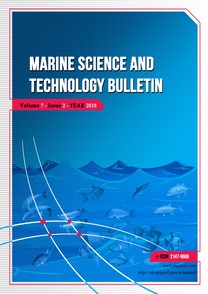Forecasting Shanghai Containerized Freight Index by Using Time Series Models
Shanghai Containerized Freight Index, Volatility, Freight rates, SARIMA Container, Holt Winter,
___
- Agrawal, R. K., Muchahary, F., & Tripathi, M. M. (2018). Long term load forecasting with hourly predictions based on long-short-term-memory networks. 2018 IEEE Texas Power and Energy Conference (TPEC), 1-6. https://doi.org/10.1109/TPEC.2018.8312088
- Awal, M., & Siddique, M. (2011). Rice production in Bangladesh employing by ARIMA model. Bangladesh Journal of Agricultural Research, 36(1), 51-62. https://doi.org/10.3329/bjar.v36i1.9229
- BBC. (2021). Ever Given: Ship that blocked Suez Canal sets sail after deal signed. Retrieved on September 21, 2021, from https://www.bbc.com/news/world-middle-east-57746424
- Burnham, K. P., & Anderson, D.R. (Eds.), (2004). Model Selection and Multimodel Inference. Springer.
- Chen, P., Niu, A., Liu, D., Jiang, W., & Ma. B. (2018). Time series forecasting of temperatures using SARIMA: An example from Nanjing. IOP Conference Series: Materials Science and Engineering, 394(5), 052024. https://doi.org/10.1088/1757-899x/394/5/052024
- Chou, M. -T. (2017). An improved fuzzy time series theory with applications in the Shanghai containerized freight index. Journal of Marine Science and Technology, 25(4), 393-398. https://doi.org/10.6119/JMST-017-0313-1
- Dasyam, R., Pal, S., Rao, V. S., & Bhattacharyya, B. (2015). Time series modeling for trend analysis and forecasting wheat production of India. International Journal of Agriculture, Environment and Biotechnology, 8(2), 303-308. https://doi.org/10.5958/2230-732X.2015.00037.6
- Dickey, D. A., & Fuller, W. A. (1979). Distribution of the estimators for autoregressive time series with a unit root. Journal of the American Statistical Association, 74(366a), 427-431. https://doi.org/10.1080/01621459.1979.10482531
- Dixon, M. (2010). Hedging your bets. Containerisation International Year Book., National Magazine Company.
- Drewry. (2021). COVID-19 to stifle container port investment. Retrieved on September 21, 2021, from https://www.drewry.co.uk/news/covid-19-to-stifle-container-port-investment
- Dunya. (2021). Retrieved on September 21, 2021, from https://www.dunya.com/sektorler/lojistik/noel-sparisleri-one-cekildi-navlunda-yeni-zam-kapida-haberi-629042
- Farhan, J., & Ong, G. P. (2018). Forecasting seasonal container throughput at international ports using SARIMA models. Maritime Economics & Logistics, 20, 131-148. https://doi.org/10.1057/mel.2016.13
- Goulielmos, A. M., & Psifia, M.-E. (2009). Forecasting weekly freight rates for one-year time charter 65 000 dwt bulk carrier, 1989–2008, using nonlinear methods. Maritime Policy & Management, 36(5), 411-436. https://doi.org/10.1080/03088830903187150
- Khogali, K. A., Odhiambo, J. W., & Owino. J. O. (2002). On smoothing time series data using a classical moving average formula. Interstat: Statistics on the Internet, Retrieved on September 21, 2021, from https://www.researchgate.net/profile/John-Odhiambo-3/publication/241913389_ON_SMOOTHING_TIME_SERIES_DATA_USING_A_CLASSICAL_MOVING_AVERAGE_FORMULA/links/58f78156aca2726498870d23/ON-SMOOTHING-TIME-SERIES-DATA-USING-A-CLASSICAL-MOVING-AVERAGE-FORMULA.pdf
- Klein, A., & Verbeke. A. (1987). The design of an optimal short term forecasting system for seaport management: an application to the port of Antwerp. International Journal of Transport Economics/Rivista internazionale di economia dei trasporti, 14(1), 57-70.
- Lucas, J. M., & Saccucci, M. S. (1990). Exponentially weighted moving average control schemes: Properties and enhancements. Technometrics, 32(1), 1-12. https://doi.org/10.1080/00401706.1990.10484583
- Munim, Z. H., & Schramm, H. -J. (2017). Forecasting container shipping freight rates for the Far East–Northern Europe trade lane. Maritime Economics & Logistics, 19, 106-125. https://doi.org/10.1057/s41278-016-0051-7
- Pang, G., & Gebka, B. (2017). Forecasting container throughput using aggregate or terminal-specific data? The case of Tanjung Priok Port, Indonesia. International Journal of Production Research, 55(9), 2454-2469. https://doi.org/10.1080/00207543.2016.1227102
- Shanghai Shipping Exchange. (2020). Shanghai Export Containerized Freight Index (SCFI). Retrieved on September 21, 2021, from http://en.sse.net.cn/
- Ship Technology. (2021). Global shipping container shortage: the story so far. Retrieved on September 21, 2021, from https://www.ship-technology.com/features/global-shipping-container-shortage-the-story-so-far/
- Shu, M. H., Nguyen, T. L., Hsu, B., Lu, C., & Huang, J. -C. (2014). Forecasting cargo throughput with modified seasonal ARIMA models. WSEAS Transactions on Mathematics, 13, 171-181.
- Stopford, M. (2009). Maritime Economics (3rd ed.). Routledge.
- Yang, Y., Zheng, H., & Zhang, R. (2017). Prediction and analysis of aircraft failure rate based on SARIMA model. 2nd IEEE International Conference on Computational Intelligence and Applications (ICCIA), 2017, 567-571, https://doi.org/10.1109/CIAPP.2017.8167281
- ISSN: 2147-9666
- Yayın Aralığı: 4
- Başlangıç: 2012
- Yayıncı: Adem Yavuz SÖNMEZ
Olaniyi Alaba Olopade, Henry Eyina Dienye, Sonia Adesuwa Obasuyi
The Maximum Size and Age of Umbrina cirrosa (Linnaeus, 1758) in the World
Kaan KOYUNCU, Leyla TAVACIOĞLU
Forecasting Shanghai Containerized Freight Index by Using Time Series Models
Kaan Koyuncu, Leyla Tavacıoğlu
Jaro Omar Ajik, Albaris Beteh Tahiluddin
Rosemary (Rosmarinus officinalis) as a Preservative Agent in Canned Bonito (Sarda sarda)
